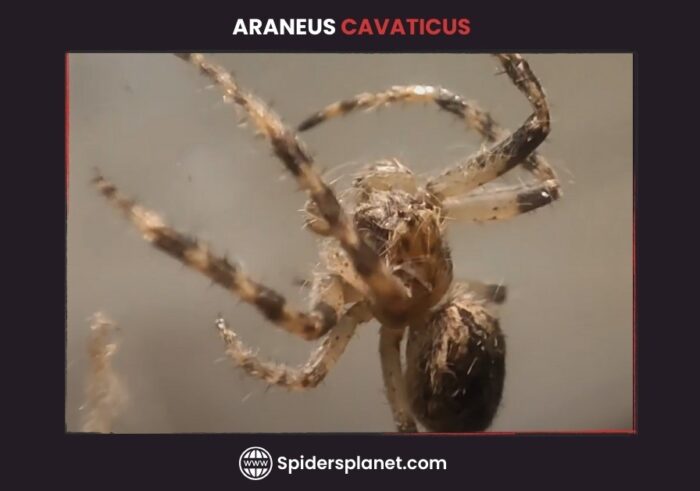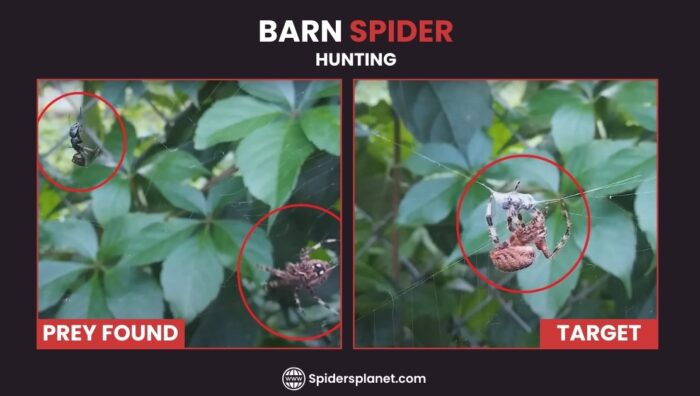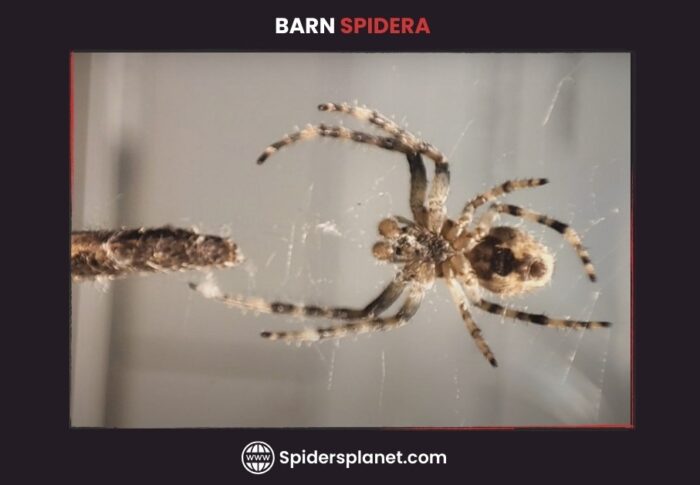Have you ever met with a special spider that comes out at night? This shy nocturnal spider is called the Barn spider (Araneus cavaticus), mostly found in North America.
It is a tiny artist, often yellow and brown, that makes beautiful webs in places like barns and other wooden structures made by people, which is why they are called barn spiders.
Every day, the Araneus Cavaticus, like its orb-weaver relatives, spins a fresh web.
One interesting thing about them is that they inspired the character Charlotte in the book “Charlotte’s Web” by E. B. White.
This article explores how it creates its amazing webs and why it is important in nature, some cool facts, appearance, habitat, diet, life cycle and more.
Let’s start to learn about this amazing creature and keep reading…!
Barn Spider (Araneus Cavaticus) Description:
Scientific Name and Family:
The Barn spider belongs to the Kingdom Animalia, the Class Arachnida, and the Family Araneidae.
The genus to which it belongs is Araneus, and its specific scientific name is A. cavaticus.
Species:
There are actually several species that commonly get called “barn spiders,” but the two most well-known ones are:
- Araneus cavaticus, famously featured in E.B. White’s “Charlotte’s Web,” is the North American barn spider. Recognizable by its yellow and brown coloring, speckled body, and striped legs, it makes detailed webs in safe corners of barns and sheds.
- Neoscona crucifera, another notable orb-weaver, is also known as the spotted orb weaver or Hentz orb weaver (it is named after Nicholas Marcellus Hentz. He was the first person to gather and categorize spiders in North America. He wrote about his discoveries and described 141 spider species in the journal of the Boston Society of Natural History). Mostly found in North and South America, it bears a resemblance to Araneus cavaticus, has more noticeable markings, and is a bit smaller. This spider likes to build its webs in open places like fields and forests.
Alternative scientific names that have been associated with the same species include:
- Epeira cavatica
- Epeira cinerea
- Aranea cavatica
Body / Anatomy:

The Araneus Cavaticus might look simple, but its body is super interesting for making webs. It has a part called the cephalothorax, where the brain and fangs are, and eight legs for building webs.
Its eyes help it see light and movement to catch bugs. The fangs inject venom to catch insects, and little things called pedipalps help it sense and touch.
The round belly holds important stuff, and spinnerets at the back make silk for making webs. Underneath, it has book lungs to breathe.
Barn spiders are not too big, with flexible bodies and leg hairs that help them move on webs. Understanding their body shows how amazing nature is, from their many eyes to the special silk they make for webs.
Appearance:
Size:
Barn spiders come in different sizes, influenced by their species and gender. Usually, female barn spiders in North America are bigger than males, with a typical body length ranging from ¾ to 1 inch (20-25 mm).
On the other hand, males are even smaller, often measuring ½ to ¾ inch (12-19 mm).
Color:
Barn spiders have a wide range of colors, often using them as camouflage in their web homes.
Most have a light yellow or brown color with speckles and striped legs, while some barn spiders can feature shades of grey and black, hues of orange and green, and noticeable white markings on their undersides.
Interestingly, within the same species, there can be variations in color, influenced by factors like where they live and their surroundings.
How to Identify?
To identify this tiny creature, look for physical features such as:
- Size (females are ¾ to 1 inch, males are smaller), color variations (yellow or brown with speckles, but could be gray, black, orange, or green).
- The distinct orb-shaped webs they build in sheltered corners.
- Barn spiders have eight beady eyes, a bulky and patterned abdomen, and hairy legs with a banded appearance.

- Consider the habitat (sheltered areas with flying insects) and geographic location.
- Distinguishing features from other orb-weavers include less defined markings on the abdomen, and males are smaller and thinner than females.
- Watch for barn spiders rebuilding their webs at night. They start by making a sunburst shape and then spin the circular part in a spiral pattern from the outside to the center. This careful process happens every night, highlighting the spider’s dedication to maintaining its web.
What They Like to Eat?
Barn spiders love feeding on prey that gets caught in their sticky webs. They are carnivores, and flies, moths, and mosquitoes are their favorite meals, but they will also munch on beetles, bees, and even small spiders.
Sometimes, these spiders can even catch bigger prey like lizards or frogs. What they eat depends on the season and where they live.
Habitat and Adaptation:
These spiders have a diverse range of habitats. While they are commonly associated with barns and sheds, these adaptable spiders can be found in various places, including barns, sheds, porches, and patios, where they take advantage of shelter and insect abundance.
They are also at home in gardens, woodlands, cliffs, and rock formations, contributing to natural ecosystems.
Surprisingly, barn spiders venture beyond expected places, like boats, bridges, and even urban areas, spinning webs on balconies or between buildings.
Their habitat choice depends on factors like the availability of prey, secure structures for web building, and the right temperature and humidity levels.
Behavior and Hunting:
Barn spiders are night spiders (nocturnal) busy at night, making and fixing their webs. They are expert hunters, using their webs to catch insects, and can even sense tiny movements with their leg hairs.

Females prefer being alone and protecting their eggs, while males visit for mating. If any spider tries to build a web in the same spot or live in their web, Araneus Cavaticus can be aggressive.
Their colors help them hide, and they put their webs in smart places to catch lots of bugs. Besides insects, they can catch bigger things like lizards.
These spiders are helpful because they control insect numbers, keeping the environment balanced.
When barn spiders feel threatened, they do a little dance in their webs by bouncing up and down and shaking their webs to show that it is their space and also to help them assert control and let others know to stay away.
Habits – Araneus Cavaticus Webs:
Araneus Cavaticus are night-time architects, creating fresh webs nightly by taking down and consuming the old ones. This smart approach conserves silk and recycles nutrients.
Their webs have special silk for different purposes; sticky spirals catch prey, while non-sticky radial threads help the spider move around its intricate design.
Tiny hairs on the spider’s legs act like sensors, feeling vibrations in the web. This alerts them when prey is caught, and they skillfully approach and capture their meal.
These spiders are like skilled builders and hunters, making the most of their silk and web design.
Lifecycle and Reproduction:
When it is time for love in the Araneus Cavaticus world, the females take the lead. After molting a few times, they release special scents called pheromones, weaving invisible threads with these alluring chemicals.
The smaller males, being careful not to be mistaken for a tasty meal, detect these scents and cautiously approach the female’s web.
To win her over, they send vibrations through the web, creating a unique courtship dance. If she likes the performance, she lets him get closer to mating.

Using special parts called pedipalps, the male transfers sperm to the female genital opening, and she stores the sperm in her ovaries, the fertilization process occurs when she decides it is time to lay eggs, typically happening approximately a month later.
The female spins a safe and cozy egg sac, often hidden away, where she can lay as many as 100 tiny eggs. With the arrival of spring, Barn spiderlings burst forth, equipped with eight legs and curious eyes, ready for independent adventures.
Propelled by silken balloons, they disperse to find new hunting grounds. Molting and growing, these youngsters develop their adult features and refine their web-spinning prowess.
Also Read: Pumpkin Patch Tarantula (Hapalopus Formosus): Ultimate Advice
Lifespan:
Barn spiders, North American Araneus cavaticus, typically live for about a year, experiencing the peak of their activity during the bustling summer months.
Various factors influence their lifespan, including species, environmental conditions, predation risks, and sexual dimorphism, with females generally living longer.
Predators:
While these skilled architects spin webs to capture their prey, they become targets themselves in a world full of predators.
Birds of prey, such as hawks and owls, with their sharp talons, pose a significant threat, while agile wasps armed with venom can skillfully navigate webs for a quick attack. Within the spider community, larger spiders may see smaller Araneus Cavaticus as potential meals, leading to cannibalism.
Even ground crawlers like lizards and frogs can sneak up on spiders near their webs. Harsh weather conditions and unintentional human encounters, such as disrupting webs or using insecticides, add further challenges to the barn spider’s survival in this complex and perilous ecosystem.
Ecological Importance:
Barn spiders play a vital role in maintaining ecological balance by controlling insect populations.
Their diverse diet, which includes beetles, ants, moths, flies, and mosquitoes, proves beneficial for agricultural and garden environments.
The nocturnal web-weaving and hunting behaviors of barn spiders contribute to the natural balance of local ecosystems, helping to keep pest numbers in check.
Their role as efficient insect predators underscores their significance in fostering a healthier environment.
Bite and Venom:
Though Barn spiders are venomous. Despite having fangs and producing venom, they generally pose little threat to humans. They are shy and non-aggressive.
They prefer to escape rather than confront, and biting humans is a last resort if they feel threatened.
Their venom is primarily aimed at insects and has minimal impact on humans. Bites may cause localized pain, swelling, and itching, akin to a mosquito bite.
While Araneus Cavaticus bites rarely need medical care, consulting a healthcare professional is advisable if you have concerns.
Safety Tips: Appreciate barn spiders from afar for safety. Touching their webs may trigger a defensive response. If handling webs is necessary, consider gloves and long sleeves for protection.
Quick Interesting Facts About Barn Spider:
- The Araneus Cavaticus is thought to be the inspiration for Charlotte, a character in E.B. White’s cherished children’s book “Charlotte’s Web.”
- Weave their webs in diverse locations like barns, sheds, gardens, forests, and even urban landscapes.
- They exhibit diverse coloration, and females are significantly larger than males.
- These opportunistic carnivores feast on a variety of flying insects.
- Barn spiders are skilled builders, creating and rebuilding their webs each night to efficiently catch prey.
- These spiders are primarily nocturnal and catch their food at night.
- With a lifespan of around one year, barn spiders lay egg sacs and disperse numerous spiderlings.
- Predators threats to barn spiders.
- While they possess venom, its effect on humans is very low, rarely causing more than localized discomfort similar to a mosquito bite.
- Having ecological importance in controlling insect populations.
FAQs:
If a Barn spider bites, how to treat it?
In the same way, you treat any insect bite, clean the infected area, and monitor the bite. Seek medical attention if swelling or pain worsens.
Are Barn spiders dangerous?
Not typically dangerous, they have fangs producing venom, and they bite, but their venom is mild and unlikely to cause serious harm.
Is Barn spider poisonous?
Yes, but the venom is weak and rarely harmful to humans.
How can you identify between a male and a female spider?
The differences between male and female barn spiders include size and appearance, with females being larger and having a rounder abdomen.
What kind of spider is Charlotte in Charlotte’s Web?
The barn spider, scientifically known as Araneus cavaticus, is possibly a reference to the famous children’s book “Charlotte’s Web” by E.B. White, where the main character is a barn spider (Cavatica) named Charlotte.
Cavatica is a clever and playful way to incorporate the scientific name of the barn spider, Araneus cavaticus, into the story.
It’s interesting to note that Charlotte’s daughter chooses to name herself Aranea, drawing a connection to her mother’s middle name and maintaining the spider theme.
How long do Barn spiders live?
Females live up to 1-2 years, while male spiders have much shorter lifespans compared to females.




Leave a Reply